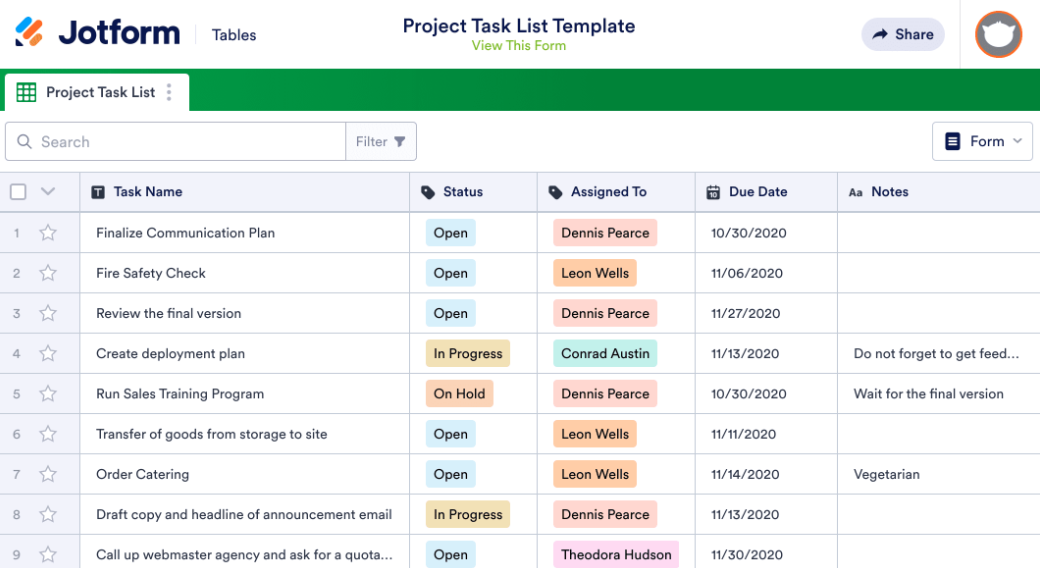How to organize a project
- Be clear about expectations
- Devise a project plan and schedule
- Track progress
- Meet regularly
- Implement a virtual workspace
- Anticipate problems
- Play to people’s strengths
- Use kanban boards
- Invest in software
If you’re a project manager, your job isn’t easy. You have to juggle employees, tasks, bosses, and budgets — all against a loud, ticking clock — making your job extremely stressful and overwhelming. (If you’ve wanted to give up, you’re not alone: Of 220 project managers surveyed in 2021, 37 percent said they’ve thought about quitting the field.)
But since you’ve been placed in this position for a reason — i.e. you’re hardworking, trustworthy, reliable, and smart — it’s essential to know how to organize a project effectively and efficiently so that you meet your deadlines and meet your goals.
Why project organization is so important
With successful project management, you can help your team focus on their tasks and assignments, open up lines of communication and collaboration about what will realistically work and what won’t, ensure strategies stay aligned, and track project progress throughout — all from the planning stages to the final presentation.
Not only will staying organized make your job easier — and much less nerve-racking — but your company will spend less time, money, and resources across the board.
How to organize a project
So, now you know why it’s so important. Let’s go over nine tips on how to manage a project successfully.
1. Be clear about expectations
One of the easiest ways to derail a project before it even begins is by setting unrealistic goals and objectives and not communicating with your team. By first defining the what and why of the project — its scope and priorities, for example — it’ll be much easier for you to explain and plan the how and when you and your team will execute everything.
2. Devise a project plan and schedule
Once you’ve established the objective, the next step in how to manage a project is to plan it all out, including the timeline, budget, resources, and a breakdown of who’s responsible for each task and assignment. Then you can lay out a realistic schedule of tasks to help you get organized. Team members then have the opportunity to raise any concerns or ask any questions they may have.
3. Track progress
To properly manage your project, you need to know how it’s going at all times, and the best way to do that is by implementing a system to track progress. To get started, simply create a form or template that lists tasks, who they’re assigned to, when they should get underway, when they should be complete, and what their current status is. This way, you simultaneously ensure you’re meeting your deadlines and holding each employee accountable for their part in the project.
4. Meet regularly
Frequently meeting with your team — whether in person, on the phone, or using video conferencing — ensures everyone stays focused, accountable, and on track with the project. Check-ins don’t have to be every day, either. Schedule them around specific deadlines, for example, and consider meeting more frequently as the project progresses to its final stages.
5. Implement a virtual workspace
To promote ongoing communication, collaboration, and transparency — especially if you work or your team members work remotely — consider collecting all your data, charts, and documents into one shareable, virtual workspace everyone on your team can access.
6. Anticipate problems
No matter how many meetings you hold or how far out your data is projected, issues will crop up, so it’s smart to be prepared. Give yourself some wiggle room in your project planning, scheduling, and budget to tackle these issues when they inevitably arise.
7. Play to people’s strengths
Even though you’re the appointed project manager, it’s unlikely you hand-selected your team. Instead, someone probably gave you a group of individuals to manage with various work ethics, experiences, and backgrounds (not to mention personal differences). Being aware of and respecting everyone’s strengths and weaknesses is half the battle of managing a project, so keep that in mind when assigning tasks.
8. Use kanban boards
A kanban board is one of the most beneficial tools for figuring out how to organize a project. Popular with project managers from all industries, kanban boards provide a visual representation of everyone’s workflow and workload, organized in columns representing various stages of the project. Similar to other project management tools, kanban boards are a great way to simplify team communication, collaboration, and productivity.
9. Invest in software
While it’s not essential, investing in some form of project management software is definitely advantageous. Though only 22 percent of companies currently use some form of project management tool, the most successful projects — 77 percent of them, in fact — use project management software to their advantage.
With the right project management tool, like online form builder Jotform, you can keep your project on track and everyone on the same page using customizable forms, templates, and applications, like employee timesheets, end-of-day reports, and task list charts.
At its core, successful project management is all about properly planning and executing an assignment using the least amount of money and resources. By following these tips, you’ll undoubtedly do just that, regardless of your industry or team size.
Photo by Memento Media on Unsplash






























Send Comment: